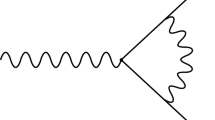Abstract
We point out that in unimodular gravity Newton’s constant is an essential coupling, i.e. it is independent of field redefinitions. We illustrate the consequences of this fact by a calculation in a standard simple approximation, showing that in this case the renormalization group flow of Newton’s constant is gauge and parametrization independent.
Similar content being viewed by others
Notes
In order to do the functional variation, we can either remember that the linear perturbation must be traceless, and thus straightforwardly obtain the traceless equations (2.3), or we can include the unimodular constraint in the action by means of a Lagrange multiplier and then eliminate the latter from the equations of motion, obtaining of course the same result.
Note that because \(h_\mu ^\mu =0\) we have only two possible ultralocal terms at order \(\epsilon ^2\) instead of the general four discussed in [28].
References
Einstein, A.: Do gravitational fields play an essential part in the structure of the elementary particles of matter? Sitzungsber. Preuss. Akad. Wiss. Berlin Math. Phys. 1919, 433 (1919)
van der Bij, J.J., van Dam, H., Ng, Y.J.: The exchange of massless spin two particles. Physica 116A, 307 (1982)
Unruh, W.G.: A unimodular theory of canonical quantum gravity. Phys. Rev. D 40, 1048 (1989)
Henneaux, M., Teitelboim, C.: The cosmological constant and general covariance. Phys. Lett. B 222, 195 (1989)
Alvarez, E.: Can one tell Einstein’s unimodular theory from Einstein’s general relativity? JHEP 03, 002 (2005). arXiv:hep-th/0501146
Smolin, L.: The Quantization of unimodular gravity and the cosmological constant problems, Phys. Rev. D 80, 084003 (2009). arXiv:0904.4841
Ellis, G. F. R., van Elst, H., Murugan, J., Uzan, J.-P.: On the trace-free Einstein equations as a viable alternative to general relativity. Class. Quant. Grav. 28, 225007 (2011). arXiv:1008.1196
Saltas, I. D.: UV structure of quantum unimodular gravity. Phys. Rev. D 90, 124052 (2014). arXiv:1410.6163
Alvarez, E., Gonzalez-Martin, S., Herrero-Valea, M., Martin, C. P.: Unimodular gravity redux. Phys. Rev. D 92(6), 061502 (2015). arXiv:1505.00022
Kuchar, K.V.: Does an unspecified cosmological constant solve the problem of time in quantum gravity? Phys. Rev. D 43, 3332 (1991)
Eichhorn, A.: On unimodular quantum gravity. Class. Quant. Grav. 30, 115016 (2013). arXiv:1301.0879
Eichhorn, A.: The renormalization group flow of unimodular f(R) gravity, JHEP 04, 096 (2015). arXiv:1501.05848
Weinberg, S.: Ultraviolet divergences in quantum theories of gravitation. In: Hawking, S.W., Israel, W. (eds.) General Relativity. Cambridge University Press, Cambridge (1979)
Niedermaier, M., Reuter, M.: The asymptotic safety scenario in quantum gravity. Living Rev. Rel. 9, 5 (2006). doi:10.12942/lrr-2006-5
Reuter, M., Saueressig, F.: Quantum Einstein gravity. New J.Phys. 14, 055022 (2012). arXiv:1202.2274
Falls, K., Litim, D. F., Nikolakopoulos, K., Rahmede, C.: Further evidence for asymptotic safety of quantum gravity. arXiv:1410.4815
Demmel, M., Saueressig, F., Zanusso, O.: A proper fixed functional for four-dimensional quantum Einstein gravity. JHEP 08, 113 (2015). arXiv:1504.07656
Christiansen, N., Knorr, B., Meibohm, J., Pawlowski, J. M., Reichert, M.: Local quantum gravity. arXiv:1506.07016
Percacci, R., Vacca, G. P.: Search of scaling solutions in scalar-tensor gravity. Eur. Phys. J. C 75, 188 (2015). arXiv:1501.00888
Wegner, F.J.: Some invariance properties of the renormalization group. J. Phys. C 7, 2098 (1974)
Percacci, R., Perini, D.: Should we expect a fixed point for Newton’s constant? Class. Quant. Grav. 21, 5035 (2004). arXiv:hep-th/0401071
Benedetti, D.: Asymptotic safety goes on shell. New J.Phys. 14, 015005 (2012). arXiv:1107.3110
Buchbinder, I.L., Odintsov, S.D., Shapiro, I.L.: Effective action in quantum gravity. IOP, Bristol (1992)
Falls, K.: On the renormalisation of Newton’s constant. arXiv:1501.05331
Gies, H.: Introduction to the functional RG and applications to gauge theories. Lecture Notes Physics 852, 287 (2012). arXiv:hep-ph/0611146
Rosten, O. J.: Fundamentals of the exact renormalization group, Phys. Rept. 511, 177 (2012). arXiv:1003.1366
Dietz, J. A., Morris, T. R.: Redundant operators in the exact renormalisation group and in the f(R) approximation to asymptotic safety. JHEP 07, 064 (2013). arXiv:1306.1223
Gies, H., Knorr, B., Lippoldt, S.: Generalized parametrization dependence in quantum gravity. Phys. Rev. D 92, 084020 (2015). arXiv:1507.08859
Reuter, M.: Nonperturbative evolution equation for quantum gravity. Phys. Rev. D 57, 971 (1998). arXiv:hep-th/9605030
Wetterich, C.: Exact evolution equation for the effective potential. Phys. Lett. B 301, 90 (1993)
Morris, T.R.: The exact renormalization group and approximate solutions. Int. J. Mod. Phys. A 9, 2411 (1994). arXiv:hep-ph/9308265
Becker, D., Reuter, M.: En route to Background Independence: Broken plit-symmetry, and how to restore it with bi-metric average actions. Ann. Phys. 350, 225 (2014). arXiv:1404.4537
Christiansen, N., Litim, D. F., Pawlowski, J. M., Rodigast, A.: Fixed points and infrared completion of quantum gravity, Phys. Lett. B 728, 114 (2014). arXiv:1209.4038
Codello, A., D’Odorico, G., Pagani, C.: Consistent closure of renormalization group flow equations in quantum gravity. Phys. Rev. D 89, 081701 (2014). arXiv:1304.4777
Benedetti, D., Groh, K., Machado, P. F., Saueressig, F.: The universal RG machine. JHEP 06, 079 (2011). arXiv:1012.3081
Alvarez, E., Faedo, A.F., Lopez-Villarejo, J.J.: Ultraviolet behavior of transverse gravity. JHEP 10, 023 (2008). arXiv:0807.1293
Buchmuller, W., Dragon, N.: Gauge fixing and the cosmological constant. Phys. Lett. B 223, 313 (1989)
Dou, D., Percacci, R.: The running gravitational couplings. Class. Quant. Grav. 15, 3449 (1998). arXiv:hep-th/9707239
Benedetti, D., Machado, P.F., Saueressig, F.: Taming perturbative divergences in asymptotically safe gravity. Nucl. Phys. B824, 168 (2010). arXiv:0902.4630
Codello, A., Percacci, R., Rahmede, C.: Investigating the ultraviolet properties of gravity with a Wilsonian renormalization group equation. Ann. Phys. 324, 414 (2009). arXiv:0805.2909
Litim, D. F.: Optimised renormalisation group flows. Phys. Rev. D64, 105007 (2001). arXiv:hep-th/0103195
Anber, M. M., Donoghue, J. F.: On the running of the gravitational constant. Phys. Rev. D85, 104016 (2012). arXiv:1111.2875
Bjerrum-Bohr, N. E. J., Donoghue, J. F., Holstein, B. R.: Quantum gravitational corrections to the nonrelativistic scattering potential of two masses. Phys. Rev. D67, 084033 (2003). arXiv:hep-th/0211072. [Erratum: Phys. Rev.D71,069903(2005)]
Author information
Authors and Affiliations
Corresponding author
Rights and permissions
About this article
Cite this article
Benedetti, D. Essential nature of Newton’s constant in unimodular gravity. Gen Relativ Gravit 48, 68 (2016). https://doi.org/10.1007/s10714-016-2060-3
Received:
Accepted:
Published:
DOI: https://doi.org/10.1007/s10714-016-2060-3




